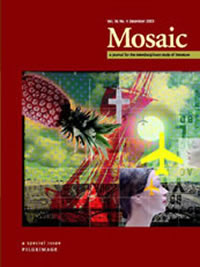Issue 36.4
Overview

Special Issue: Pilgrimage
Published: December 2003
View the issue introduction or see the issue summary and contents below.
13 essays, totalling 224 pages
$17.95 CAD
In this special issue of Mosaic, pilgrimage is analyzed both as a strategy of resistance to oppositional hierarchies and as riddled with problematic oppositions. The essays in this issue approach the theme from a range of theories, including the modern and postmodern, metaphor, Orientalism, ethnographic writing, trauma, memory, and story-telling. These theories are applied to pilgrims Margery Kempe and John Bunyan, but also to less expected figures like Virginia Woolf, Antonine Maillet, Pierre Loti, and the Afro-Cuban poet Nancy Morejón.
Crossings: An Interview with Erin MouréDawne McCance Mosaic initiated this interview in Calgary, Alberta, during the May 2003 Alley Alley Home Free North American Poetry and Poetics Conference at which Erin Mouré delivered the keynote address, “Poetry’s Stakes Today.” We are pleased to publish the interview here. | |
Liminal Space of the Aboiteaux: Pilgrimage in Maillet’s PélagieJane Slemon Antonine Maillet’s Pélagie employs the aboiteaux as metaphor for Acadian pilgrimage; the hole in a dike through which water trickles to the sea represents the liminal space that characterizes Acadian experience of exile and return. Storytelling is a passageway that connects invented past to imagined future. | |
Pilgrimage as Opposition in Latin American Women’s LiteratureFelicia Fahey This essay examines two Latin American novels that represent secular pilgrimage as a form of opposition. Authors Alina Diaconú and Laura Restrepo reformulate pilgrimage as an individual practice that prompts significant subjective transformation and leads the protagonist to dwell on and form oppositional alliances in the interstices of the nation-state. | |
Allegory, Maps, and Modernity: Cognitive Change from Bunyan to ForsterPeter Crisp Contemporary metaphor theory provides an important framework for relating human cognitive universals to cultural and historical variation. This essay analyzes important differences in the journey metaphors of John Bunyan’s The Pilgrim’s Progress and E.M. Forster’s “The Other Side of the Hedge,” relating these to the emergence of modernity. | |
Postcolonial Pilgrimage: Toward an Afro-Cuban Identity in the Poetry of Nancy MorejónAntonio D. Tillis This essay examines identity, place, and cultural marronage in three poems by the Cuban national poet Nancy Morejón, especially in terms of the postcolonial pilgrimage of people of African descent in the Americas in general, Cuba in particular. | |
The Nostalgia of Nowhere: Pierre Loti’s Utopian SpacesThomas J.D. Armbrecht Académie Française member Pierre Loti is known for his depictions of the foreign and the exotic. Treating work by Barthes, Said, and various other Loti scholars, this essay makes connections between Loti’s writing and his home in an effort to broaden the understanding of Loti’s novelistic representations of himself. | |
From Maps to Monuments: Elizabeth Bishop’s Shoreline PoemsJonathan Ellis Elizabeth Bishop’s overlapping of temporality and spatiality seems to anticipate the shift from modernism to postmodernism, but a closer look at early shoreline poems such as “The Map” and “The Monument” undermines this assumption. This essay argues that Bishop’s depiction of liminal space is continually haunted by traumatic childhood memories, questioning simplistic definitions of cultural change. | |
Cyberpunk Pilgrimages: Kathy Acker Inside/Outside of the SublimeLynn Hughey Kathy Acker’s work, as an example of cyberpunk literature, is a postmodern variation on Nordic and Christian pilgrimage, as well as on the mediaeval women’s testimonials. Acker’s work perpetuates a literary nomadism from two distinct positions: first, inside of a subject’s damaged imaginary, and second, outside into a world that is characterized by the sublime. | |
Modern Pilgrimage and the Authority of Space in Forster’s A Room with a View and Woolf’s The Voyage OutAlexandra Peat Virginia Woolf’s The Voyage Out and E.M. Forster’s A Room with a View adapt the pilgrimage trope in order to create new travel narratives for the modern age. This essay examines the formation of various sacred spaces that disrupt both historical and geographical paradigms and create instead a palimpsest of time and space. | |
Ethnographic Pilgrimages in Depression-Era AmericaDan Shiffman Examining the reportage of Erskine Caldwell, James Agee, and Louis Adamic, this essay argues for social documentary to advance pluralistic awareness of people and cultures. Such as ethnographic approach is not preoccupied with maintaining objectivity nor in drawing fixed conclusions but instead seeks cross-cultural understanding that emerges from the carefully considered relationship of ethnographer and subjects. | |
Salvation, Storytelling, and Pilgrimage in Tim O’Brien’s The Things They CarriedAlex Vernon This essay examines The Things They Carried in relation to John Bunyan’s The Pilgrim’s Progress and Victor Turner’s investigations of religious pilgrimages, suggesting that O’Brien’s novel asks every war writer’s essential question: Can a veteran achieve moral or spiritual redemption through storytelling? | |
Whose Turn is it to Cook? Communitas and Pilgrimage QuestionedDarlene M. Juschka Victor Turner sees pilgrimage as a liminoid phenomenon: one steps out of social structures in order to join a community of participants who share the journey. In this essay I call into question the implicit Turnerian concept of a socially unencumbered human by focussing on pilgrimage’s power differentials. | |
In the Eye of the StormCees Nooteboom (Translated by Ann Kelland) What follows is an excerpt from The Nomad Hotel, a yet-to-be published book by Cees Nooteboom. Mosaic is pleased to publish the excerpt here. |